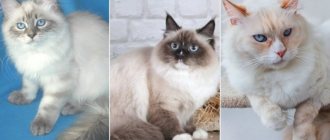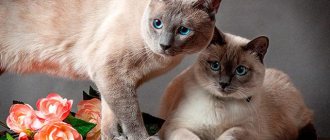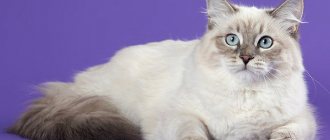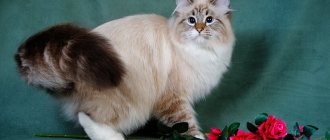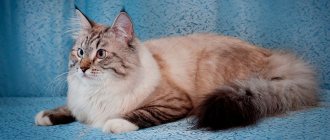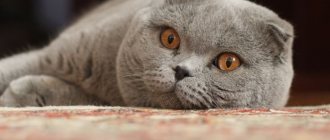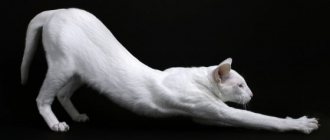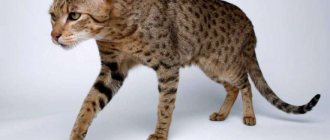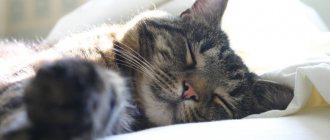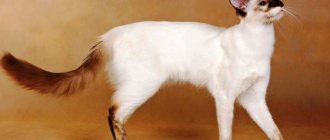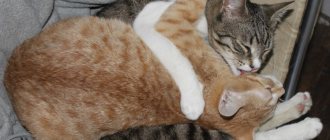The Neva Masquerade cat is an independent subspecies of the Siberian breed with sky-blue eyes and color-point colors. These furry creatures combine natural grace, strength and a very gentle character.
Let's figure out where this breed came from, how to care for it, how to choose the right kitten, as well as other issues that the future owner of a Nevaka needs to know.
Brief history of the breed
The Neva Masquerade appeared in the 80s of the last century. It is reliably known that its ancestor was a Siberian cat. But where the Nevakasiam color comes from has not yet been established exactly.
According to one version, the unusual fur coat is a sign of kinship with pointing Persians. According to another theory, this is the result of mating Siberian cats with Siamese.
The work on breeding Nevaks was led by Olga Mironova, a well-known Leningrad felinologist and an international expert. In 1988, representatives of the breed were demonstrated for the first time at an exhibition.
As masquerade cats became popularized, metropolitan breeders became interested in them. The Moscow team of felinologists worked independently of their Leningrad colleagues, thanks to which the Nevaks had several color options.
In the late 80s, the cat breed, which was bred by St. Petersburg felinologists, began to be popularized abroad. In 1992, the Neva Masquerade received recognition from the WCF. But most felinological associations still consider the breed to be a variety of Siberians.
Interesting Facts
Despite the relative youth of the breed, the origins of which are the St. Petersburg felinological club “Kotofey”, a lot of interesting things have already happened to the Neva Masquerade cat:
- Some experts are sure that the unusual color of these cats is a consequence of the manifestation of the recessive albinism gene, which gives the color-point color.
- The saliva of Neva masquerade monkeys contains a minimum of antigens. Therefore, cats of this breed rarely cause allergies.
- The Neva Masquerade cat named Blue-Eyed Angel starred in the Hollywood film “Nine Lives”.
- The breed owes its name to the unusual pattern on its face and the river on which the Northern capital of Russia stands. In an abbreviated version, the name sounds like “newak” or “carnival cat.”
Breed description, standards, appearance
Nevaki are representative cats with pronounced aristocratic manners. The main distinguishing feature of the breed is considered to be a luxurious, elegant fur coat that harmonizes with sky-colored eyes.
Visually, the Neva masquerade cat resembles its Siberian ancestor. A detailed description of the breed is presented in the standard developed by the IFA system in 1990.
Dimensions and weight
Neva Masquerade cats are large cats with strong bones, a dense build and pronounced sexual dimorphism. The standard sets clear requirements for the size of adult individuals. The female weighs 6-7 kg, the male weighs 8-10 kg.
The Neva masquerade kitten is born weighing 120-160 g and grows quickly. To understand how correctly it is developing, a special table has been developed that shows the weight by month.
| Age, months | Weight, kg |
| 2 | 1,2-1,6 |
| 3 | 1,8-2,3 |
| 4 | 2,5-3,8 |
| 5 | 3,0-5,5 |
| 6 | 3,9-6,2 |
| 7-8 | 4,2-6,9 |
| 9-11 | 5,0-8,4 |
Anatomical characteristics
A typical representative of the Neva Masquerade breed should meet the following description:
- The head is proportional, trapezoidal with smooth outlines, a low rounded forehead, a wide nose and low cheekbones. The chin is powerful, the jaws are developed, the cheeks are plump. There is no stop.
- The eyes are slanted and rounded. The iris of masquerade cats is colored blue. Nevaks of red point color have eyes that appear deep blue.
- The ears are medium in size, wide at the base, with rounded tips. Slightly tilted forward. The outer contour of the ear begins just above eye level.
- The body is harmonious, of medium length with massive bones, a short neck, developed muscles and a voluminous chest.
- The limbs are strong, moderately long with large round paws. The interdigital space is overgrown with tufts of hair.
- The tail is of medium length and looks like a fox's. With a rounded tip and rich edge.
Color and coat type
The entire body of the Neva masquerade cat is covered with long or semi-long hair with a water-repellent effect. The hair on the back is coarser, while the hair on the sides is softer. An important characteristic of a chic Nevaka fur coat is the lack of tendency to form tangles.
Representatives of the breed have very developed decorative hair. Neva masquerade cats have thick “pants” on their paws, a “collar” on their necks, and a luxurious “jabot” on their chest. During the molting period, the decorative hair completely disappears.
Under the outer coat of cats of this breed there is a double down, which thins out in the summer and becomes thicker in the winter.
On a note. The Neva Masquerade is only fluffy. A smooth-haired or short-haired cat, at best, will turn out to be a representative of a different breed, at worst, a mestizo.
The Neva Masquerade standard allows for several color options. According to him, the following colors are found in the breed:
- tortoiseshell point - combines red and black shades;
- silver point – provides for the presence of a silver color;
- tabby point – there are pronounced stripes in the dark areas;
- red point - with cold zones of red and red colors;
- blue point and blue tabby point - there are blue and gray shades;
- seal point and seal tabby point - with black or dark brown markings.
On a note. Neva Masquerade kittens have snow-white fur at birth. As they grow older, dark markings appear on their body.
Possible breed defects
Flaws in appearance, in the presence of which a non-vacant cannot receive a high expert assessment:
- thin or long limbs;
- small, deep-set or completely round eyes;
- narrow or elongated muzzle;
- ears set too high, low or too close;
- weak bones;
- lack of hair in the interdigital space;
- Long neck;
- hairless or pointed tail;
- small paws;
- Coarse, patchy or dull coat;
- point in chocolate-lilac tones.
Birth of cubs
After giving birth, the mother cat licks the newborns, gnaws their umbilical cord, and the owner of the nursery determines the sex, weighs each of them, and enters the data into a standard table by month, with which the individual indicators of the growing kittens are compared:
Newborns are born blind and deaf. Surprisingly, their instinct of self-preservation and sense of smell allows them to accurately find their mother’s nipples.
Interesting! It has been noticed that even in the first hours of birth, babies sense strangers and hiss threateningly if they are picked up. They can also purr rather loudly when they find a nipple and start eating.
Character and temperament
The Neva Masquerade is a calm cat with an easy-going disposition and a stable psyche. She is never intrusive and rarely loses her temper. Despite its balanced character, the Neva Masquerade is a cheerful cat that remains playful into old age.
Representatives of this breed are true individualists with aristocratic manners. Nevaks demand respect and forever lose trust in anyone who even once yells or hits them.
On a note. Affectionate and patient Neva masquerade cats subtly sense not only the mood, but also the state of health of their owners. They can lie on sore spots.
Breed and children
Neva Masquerade gets along well with children of all ages. An adult cat condescendingly watches childish pranks and is patient with their “caresses.” But a newborn kitten, carried away by play, can bite or scratch the baby.
Breed and other animals
The Neva Masquerade gets along well not only with its brothers, but also with friendly dogs. A cat of this breed can coexist peacefully with birds and small rodents, but only if it grew up with them. Otherwise, the Nevak will perceive them as prey.
First day after purchase
When you bring your kitten home, handle it carefully. Let him calmly get used to the new place and explore all corners.
Don't scare him, remember that this is a small child, only a cat's. Of course, he will be scared and unusual, and in the first few days the baby will cry and worry.
This is normal, help the kitten through this time. Talk to him more often, unobtrusively take him in your arms.
To help the kitten quickly remember its name and respond to it, call it by name when petting or feeding it. You should immediately show the place where the tray is.
But it doesn’t matter if the little furry doesn’t remember this place the first time. In this case, you should not poke his nose into the puddle, but rather wet a piece of paper in it and put it in the tray. This way the kitten will quickly understand what’s what.
Thus, the baby will soon get used to the new home and new owners. Treat him with affection and respect, and you will have a wonderful mustachioed and tailed friend.
How to choose the right kitten
To be sure that the animal is purebred, you need to buy it from trusted breeders or nurseries that specialize in breeding this breed of cats. A small Neva Masquerade must have a certificate confirming its origin, and a veterinary passport with vaccination marks.
After making sure that everything is in order with the documents, you need to pay attention to the conditions in which the kittens and their mother are kept. The nursery should be clean and comfortable. Little nevaks who grow up in decent conditions do not show signs of cowardice or aggression. They are not afraid of extraneous sounds and do not hide from strangers.
Healthy Neva Masquerade kittens have clean eyes and ears, soft bellies, fluffy fur and smooth skin without scratching or rashes. They do not have an unpleasant odor from their mouths or dirt under their tails.
On a note. To reveal the character traits of the nevak you like, you need to start a game with the kitten. It also doesn't hurt to observe the mother cat's behavior a little, since many traits are inherited.
Kitten care
Responsible and competent breeders sell Neva Masquerade kittens no earlier than they are 3 months old. By this age, babies can already exist without a mother.
Three-month-old nevaks eat many foods on their own, are accustomed to a scratching post and go to the tray. Therefore, new owners can only show their pets where they can eat, rest and relieve themselves, and also give them time to adapt.
Especially for the arrival of a Nevak kitten, they buy a “dowry” for it:
- tray and filler;
- bed or house;
- several toys;
- grooming tools;
- hygienic cosmetics;
- bowls for food and water;
- carrying bag
For safety reasons, wires, indoor plants, household chemicals, and fragile and small objects are hidden from the small Neva Masquerade breed. And to avoid unnecessary stress, at first the kitten is fed what the breeder advised. New foods are introduced into the Nevak’s diet gradually and the reaction of the pet’s body is carefully observed. While the kitten is small, it is fed little by little, but often:
- 3-6 months – 4 times a day;
- 6-11 months – 3 times a day.
A one-year-old Neva masquerade cat is transferred to two meals a day.
Health of the Neva Masquerade
Nevaks can boast of strong immunity. The Neva Masquerade Dancers owe their health to the Siberians. These aboriginal cats were hardened by nature, and the addition of a new color did not bring about critical changes.
To increase average life expectancy, it is enough to follow standard preventive measures. Get your cat vaccinated and treated for parasites every year. Infections, helminths and fleas affect even those who live in an apartment all their lives. Also visit your veterinarian regularly to identify possible hidden pathology at an early stage.
Possible diseases
Due to the long hair, bezoars, that is, hairballs, quickly accumulate in the cat’s stomach. Usually animals regurgitate them on their own, but sometimes their quantity is too large. This can lead to intestinal blockage and even rupture. For prevention purposes, it is recommended to give your pet a special paste that helps remove hairs.
Among hereditary diseases, hypertrophic cardiomyopathy is worth noting. In a sick animal, blood stagnates in the pulmonary vessels. This is accompanied by increased heart rate and fainting, but sometimes the pathology is asymptomatic. The milder the symptoms, the more favorable the prognosis. Timely treatment helps to avoid complications and maintain quality of life.
Reproductive health
Pregnancy and childbirth in Nevaks are easy, so breeders often help the future offspring to appear at home. Most often, a cat gives birth on the 64th day after mating 3-4 kittens.
The first mating is carried out no earlier than the third heat. This reduces the likelihood of the death of a young female and the birth of a weak litter. It is also not recommended to untie cats immediately after puberty. At 9 months they begin to show interest in the opposite sex, but are not yet able to participate in breeding. When mating with such a partner, misfires often occur, so fertilization does not occur even after several meetings.
For pets not involved in breeding, it is recommended to undergo castration or sterilization. The first operation is more effective. It not only eliminates the ability to reproduce, but also suppresses sexual desire. The operated pet ceases to suffer from the opposite sex and receives protection from a number of dangerous diseases.
Care and maintenance
Neva masquerade cats are unpretentious animals that adapt to life in any conditions. Both a city apartment and a private house are equally suitable for keeping representatives of the breed.
For a newbie, be sure to provide a cozy place to sleep and a secluded corner for the toilet. The litter tray for a large shaggy cat of this breed is wide and deep, and the filler is filled with large granules. Otherwise, caring for nevaks comes down to simple hygiene procedures and a balanced diet.
- To remove yellowish plaque and prevent the formation of tartar, brush your cat's teeth weekly. This is done carefully, using a silicone brush and a special paste that does not foam.
- The Nevak's eyes and ears are regularly examined for the presence of purulent or foul-smelling discharge and wiped with cotton pads soaked in warm boiled water.
- As they grow, the claws of a cat of this breed are shortened with a nail clipper, trying not to damage living tissue.
- The Neva Masquerade is bathed more often than representatives of other breeds. This cat is given bath treatments approximately once every 4-5 weeks. Wash the Nevaka with special shampoos for long-haired breeds, and then rinse thoroughly and dry with a silent hairdryer.
- The Nevaka's chic thick fur coat requires special attention. It is combed out 3-4 times a week with a special comb and a massage brush. During the molting period, the procedure is carried out daily.
Important! During the combing process, it is strictly forbidden to touch the Nevak’s tail. As a result of careless handling, it easily loses its beauty, and it takes a lot of time to restore the structure of the hairs growing on it.
Feeding the cat
Nevaks are unpretentious in food. They eat regular foods and dry food with equal appetite. With a natural type of nutrition, the diet of a cat of this breed is designed so that it is dominated by fresh, lean meat.
Nevaka is also given:
- porridge with water;
- dairy products;
- boiled and pureed vegetables;
- offal;
- lean sea fish;
- eggs.
It is strictly forbidden to feed a nevak with pork, onions, chocolate, river fish, pickles, smoked meats, sausages, pastries, sweets and any leftovers from the master's table.
With an industrial type of nutrition, a masquerade cat is given premium or super-premium class products, which contain all the useful substances and no questionable ingredients.
The best food for nevaks is:
- Brit Care;
- Eukanuba;
- Royal Canin;
- Farmina.
Education and physical activity
The Neva Masquerade cat is endowed with high intelligence and is easy to train. She quickly adapts to new conditions, gets used to her nickname and gets used to the tray. True, under certain circumstances, a Nevak can be stubborn.
Cats of this breed are natural hunters with excellent reactions. To realize this instinct, Nevaks need to walk in the yard.
If this is not possible, then a corner equipped with shelves and ladders is allocated for the pet.
Vaccinations and antiparasitic treatment
In order to prevent infectious diseases, the Neva Masquerade is vaccinated against calcivirosis, panleukopenia and rhinotracheitis.
- The first vaccination is given to a cat at the age of 7-8 weeks.
- After 4 weeks it is repeated, but with an anti-rabies component.
- In the future, the Nevak is vaccinated once a year.
To prevent the appearance of fleas and worms, the cat is regularly subjected to antiparasitic treatment. Anthelmintic drugs are given to Nevak once every six months and repeated after 10-14 days. To remove fleas, special shampoos, drops and collars are used.
What to know when purchasing
When purchasing a kitten, be sure to find out what diseases its parents suffered, what vaccinations it was given, whether worm prevention was carried out, whether the animal was castrated or sterilized
Examine the baby, he should be a clean, dry, active, playful kitten.
You should also ask what the kitten was fed, whether he knows how to use a tray and scratching post, and what kind of litter was used in the tray.
Pros and cons of the breed
Owners of Neva Masquerade breed cats respond about their pets mainly in a positive way. Negative reviews from owners mainly concern the animals' excessive shedding and the need to devote a lot of time to caring for the coat.
Like cats of any other breed, Nevaks have both advantages and disadvantages:
| pros | Minuses |
| Attractive exterior | Heavy shedding |
| Cleanliness | |
| High intelligence |
Neva masquerade cats are fluffy animals with an unusual color. They successfully combine external beauty, an easygoing, friendly character and high intelligence. All this more than compensates for the need to regularly clean up balls of cat hair.
How much does the Neva Masquerade cost?
The average price of the Neva Masquerade is 20 thousand rubles. How much a kitten costs depends on its class, gender, prestige of the nursery, color and other factors.
The minimum cost of the pet class is 12 thousand rubles, and for representatives of the show class you will have to pay 35 thousand rubles. Girls will also cost more, since boys are less valuable in breeding. The most expensive colors include tortoiseshell, especially if it was obtained through a gene mutation in a cat.
Do you like the article? 0
